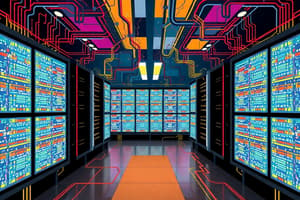Podcast
Questions and Answers
What is the primary definition of a distributed system?
What is the primary definition of a distributed system?
- A collection of independent computers appearing as a single coherent system (correct)
- A network of unconnected computers
- A single computer with multiple processors
- A system with only parallel processing capabilities
Which of the following is NOT a key advantage of distributed systems?
Which of the following is NOT a key advantage of distributed systems?
- Improved price-performance ratio
- Potential for incremental growth
- Resource sharing capabilities
- Guaranteed network security (correct)
What type of transparency hides the differences in data representation?
What type of transparency hides the differences in data representation?
- Replication transparency
- Location transparency
- Migration transparency
- Access transparency (correct)
In the context of scaling techniques, which principle is NOT considered good for decentralized algorithms?
In the context of scaling techniques, which principle is NOT considered good for decentralized algorithms?
Which model features terminals as Xterms or diskless terminals with a pool of backend processors?
Which model features terminals as Xterms or diskless terminals with a pool of backend processors?
What is a major disadvantage of distributed systems?
What is a major disadvantage of distributed systems?
Which transparency type hides that a resource may be shared by several competitive users?
Which transparency type hides that a resource may be shared by several competitive users?
What characterizes open distributed systems?
What characterizes open distributed systems?
Which of the following is an example of a centralized service that can limit scalability?
Which of the following is an example of a centralized service that can limit scalability?
In the comparison of systems, which type has the highest degree of transparency?
In the comparison of systems, which type has the highest degree of transparency?
What is a key characteristic of the workstation model?
What is a key characteristic of the workstation model?
Which scaling technique is essential for distributed systems?
Which scaling technique is essential for distributed systems?
In middleware-based systems, how many copies of the operating system exist?
In middleware-based systems, how many copies of the operating system exist?
What is the basis for communication in a Network Operating System?
What is the basis for communication in a Network Operating System?
Which model was characteristic of early networks?
Which model was characteristic of early networks?
What aspect is NOT typically associated with transparency in distributed systems?
What aspect is NOT typically associated with transparency in distributed systems?
In terms of scalability, which system type is considered the most scalable?
In terms of scalability, which system type is considered the most scalable?
What is a key feature of the client-server model?
What is a key feature of the client-server model?
Which characteristic is true about resource management in a Distributed OS?
Which characteristic is true about resource management in a Distributed OS?
What feature of open distributed systems allows them to evolve over time?
What feature of open distributed systems allows them to evolve over time?
What is the primary definition of a distributed system according to the lecture material?
What is the primary definition of a distributed system according to the lecture material?
According to Leslie Lamport's humorous definition, how do you know you have a distributed system?
According to Leslie Lamport's humorous definition, how do you know you have a distributed system?
Which of the following is NOT mentioned as a motivation for distributed systems?
Which of the following is NOT mentioned as a motivation for distributed systems?
What is the primary purpose of middleware in distributed systems?
What is the primary purpose of middleware in distributed systems?
Which law states that "bandwidth grows at least three times faster than computer power"?
Which law states that "bandwidth grows at least three times faster than computer power"?
What is the main characteristic of transparency in distributed systems related to access?
What is the main characteristic of transparency in distributed systems related to access?
Which scalability dimension refers to the maximum distance between nodes?
Which scalability dimension refers to the maximum distance between nodes?
What is a major limitation of centralized algorithms in distributed systems?
What is a major limitation of centralized algorithms in distributed systems?
Which of the following is NOT one of the ACID properties of transactions?
Which of the following is NOT one of the ACID properties of transactions?
What is one of the false assumptions (fallacies) made by first-time distributed system developers?
What is one of the false assumptions (fallacies) made by first-time distributed system developers?
In the context of distributed systems security, what does confidentiality refer to?
In the context of distributed systems security, what does confidentiality refer to?
Which type of distributed system is specifically designed for high-performance computing tasks?
Which type of distributed system is specifically designed for high-performance computing tasks?
What is a key characteristic of grid computing systems?
What is a key characteristic of grid computing systems?
Which layer in grid computing systems is responsible for handling access to multiple resources?
Which layer in grid computing systems is responsible for handling access to multiple resources?
What is the primary challenge of mobility in distributed systems?
What is the primary challenge of mobility in distributed systems?
Which QoS (Quality of Service) aspect is NOT mentioned in the lecture material?
Which QoS (Quality of Service) aspect is NOT mentioned in the lecture material?
What is a key consideration for Quality of Experience (QoE) in distributed systems?
What is a key consideration for Quality of Experience (QoE) in distributed systems?
Which type of computing system consists of homogeneous computing nodes connected by high-speed LAN?
Which type of computing system consists of homogeneous computing nodes connected by high-speed LAN?
What is the primary function of a Transaction Processing (TP) monitor?
What is the primary function of a Transaction Processing (TP) monitor?
Which requirement is essential for pervasive distributed systems?
Which requirement is essential for pervasive distributed systems?
What is one of the main shifts in technology performance concerns according to the lecture?
What is one of the main shifts in technology performance concerns according to the lecture?
In modern desktop Core systems, where is the graphics processing integrated?
In modern desktop Core systems, where is the graphics processing integrated?
What does DVFS stand for in the context of power management?
What does DVFS stand for in the context of power management?
What economic model is Cloud Computing compared to in the lecture?
What economic model is Cloud Computing compared to in the lecture?
In multi-computer systems, how does data travel between processors?
In multi-computer systems, how does data travel between processors?
What is the primary programming model used for HPC systems with multiple nodes?
What is the primary programming model used for HPC systems with multiple nodes?
How many compute nodes does the Param Ishan SC at IITG have?
How many compute nodes does the Param Ishan SC at IITG have?
According to the power consumption formula, how does power consumption relate to frequency?
According to the power consumption formula, how does power consumption relate to frequency?
What is the main limitation that led to multicore development?
What is the main limitation that led to multicore development?
What percentage of branch prediction accuracy has been achieved in single-processor systems?
What percentage of branch prediction accuracy has been achieved in single-processor systems?
When running a processor at F/3 frequency compared to F, how much more energy efficient is it?
When running a processor at F/3 frequency compared to F, how much more energy efficient is it?
What is Moore's Law's prediction about transistor count?
What is Moore's Law's prediction about transistor count?
Which of the following is NOT a type of login node in Param Ishan?
Which of the following is NOT a type of login node in Param Ishan?
What is the total high-throughput scratch space storage in Param Ishan?
What is the total high-throughput scratch space storage in Param Ishan?
Which programming model is used for accelerator-based computing in nodes?
Which programming model is used for accelerator-based computing in nodes?
What is the primary challenge with multicore programming mentioned in the lecture?
What is the primary challenge with multicore programming mentioned in the lecture?
Task scheduling on multiprocessors with more than how many processors becomes NP-Complete?
Task scheduling on multiprocessors with more than how many processors becomes NP-Complete?
What is the L1 Cache hit rate achieved in single-processor systems?
What is the L1 Cache hit rate achieved in single-processor systems?
Which network technology is used in Param Ishan?
Which network technology is used in Param Ishan?
What is the primary advantage of multiprocessors over ASICs?
What is the primary advantage of multiprocessors over ASICs?
Flashcards
Distributed System
Distributed System
A collection of independent computers appearing as a single coherent system.
Key Advantage of Distributed Systems
Key Advantage of Distributed Systems
Resource sharing capabilities.
Access Transparency
Access Transparency
Hides differences in data representation.
Not Good for Decentralized Algorithms
Not Good for Decentralized Algorithms
Signup and view all the flashcards
Processor Pool Model
Processor Pool Model
Signup and view all the flashcards
Major Disadvantage of Distributed Systems
Major Disadvantage of Distributed Systems
Signup and view all the flashcards
Concurrency Transparency
Concurrency Transparency
Signup and view all the flashcards
Open Distributed Systems
Open Distributed Systems
Signup and view all the flashcards
Limits Scalability
Limits Scalability
Signup and view all the flashcards
Highest Degree of Transparency
Highest Degree of Transparency
Signup and view all the flashcards
Workstation Model Charateristic
Workstation Model Charateristic
Signup and view all the flashcards
Essential Scaling Technique
Essential Scaling Technique
Signup and view all the flashcards
Copies of OS in Middleware
Copies of OS in Middleware
Signup and view all the flashcards
Communication in Network OS
Communication in Network OS
Signup and view all the flashcards
Characteristic of Early Networks
Characteristic of Early Networks
Signup and view all the flashcards
Not Typically Associated with Transparency
Not Typically Associated with Transparency
Signup and view all the flashcards
Most scalable type
Most scalable type
Signup and view all the flashcards
Key Feature of Client-Server Model
Key Feature of Client-Server Model
Signup and view all the flashcards
Resource Management in a Distributed OS
Resource Management in a Distributed OS
Signup and view all the flashcards
Allows evolution in open systems
Allows evolution in open systems
Signup and view all the flashcards
Signup and view all the flashcards
Study Notes
Distributed Systems
- Defined as a collection of independent computers appearing as a single coherent system
- NOT a key advantage is guaranteed network security
- A major disadvantage is network connectivity dependency
- Essential scaling technique is asynchronous communication
- Key characteristic of workstation model is processing can migrate
- Middleware-based systems have N copies of the operating system, where N equals the number of nodes
Transparency
- Access transparency hides differences in data representation
- Concurrency transparency hides that a resource is shared by competitive users
- Transparency in distributed systems does NOT typically include network protocol selection
- A Distributed OS offers the highest degree of transparency
Open Distributed Systems
- Characterized by specified services via interfaces with known protocols
- Evolve over time because of extensibility
Scaling
- Reliance on a global clock is NOT good for decentralized algorithms
- Centralized service limits scalability, example is a single server for all users
- Middleware-based OS is the most scalable system type
- Geographic scalability refers to the maximum distance between nodes
Models
- Processor pool model features terminals as Xterms or diskless terminals with a pool of backend processors
- Minicomputer model was characteristic of early networks
- Key feature of the client-server model is powerful workstations serving as servers
Distributed Operating System
- Resource management includes global, central management
- Achieve very high degree of transparency
Network Operating System
- Communication basis is messages
- Offer local services to remote clients
- File sharing handled through services like NFS or CIFS
Leslie Lamport's Definition
- A distributed system is when the crash of an unknown computer stops your work
Motivation for Distributed Systems
- NOT a motivation for distributed systems is real-time processing capabilities
Middleware
- Primary purpose is to hide heterogeneity and provide a uniform interface
- Provides high-level communication facilities
- Ensures resources remain available despite failures through replication services
- Features multiple approaches to distribution and communication
Gilder's Law
- States bandwidth grows at least three times faster than computer power
Security
- Confidentiality is protection against unauthorized disclosure
Distributed Computing Systems
- Specifically designed for high-performance computing tasks
Grid Computing Systems
- Key characteristic is managing resources from heterogeneous computers
- The collective layer is responsible for handling access to multiple resources
Mobility
- Primary challenge is location management and tracking
Quality of Service (QoS)
- Network speed is NOT a mention
Quality of Experience (QoE)
- A key consideration is user confidence
Cluster Computing
- Type of computing system consists of homogeneous computing nodes connected by high-speed LAN
Transaction Processing (TP) Monitor
- Primary function is to coordinate distributed transactions
Pervasive Distributed Systems
- Essential requirement is ad hoc composition
Technology Performance
- A main shift in technology performance concerns is power, energy, and cost
Modern Desktop Core Systems
- Graphics processing integrated into the processor itself
DVFS
- Stands for Dynamic Voltage and Frequency scaling
Cloud Computing
- Compared to the OLA/UBER rental economic model
Multi-computer systems
- data travels between processors via LAN cable
HPC Systems
- MPI is the primary programming model used for HPC systems with multiple nodes
- Param Ishan SC at IITG has 162 nodes total
- Param Ishan has 150TB total high-throughput scratch space storage
Power Consumption
- How power consumption relates to frequency is cube proportional
- When running a processor at F/3 frequency, it is 9 times more energy efficient compared to F.
Moore's Law
- Predicts transistor count doubles every 26 months.
Param Ishan
- FPGA login node does NOT exist as a login node type
- Uses FDR InfiniBand network technology
Multicore Development
- The main limitation that led to multicore development was 4GHz speed limit
- Lack of successful auto-parallelization tools is a primary challenge with multicore programming
Branch Prediction
- Single-processor systems have achieved 95% branch prediction accuracy.
Task Scheduling
- Task scheduling on multiprocessors with more than 2 processors becomes NP-Complete.
L1 Cache
- L1 Cache hit rate achieved in single-processor systems is 80%.
Multiprocessors
- Primary advantage over ASICs is programmability and flexibility.
Bus-Based Multiprocessor Systems
- Scalability is the main challenge.
SETI@home
- A grid computing project analyzes radio telescope data.
Homogeneous Multicomputer Systems
- Primary characteristic is identical nodes throughout the system.
Distributed Shared Memory Systems
- False sharing occurs when two independent processes share the same page causing unnecessary transfers.
NUMA Architectures
- Memory access speed varies for different processors in NUMA.
Microkernel Approach
- Key characteristic is most services run as separate processes.
Heterogeneous Multicomputer Systems
- Key requirement is uniform network topology.
Hypervisor
- Type 1 (bare-metal) hypervisors run directly on hardware
Network Operating Systems
- Characteristics are simple and easily modifiable
Distributed Shared Memory
- Pages are shared across machines in global address space
Middleware-Based Distributed Systems
- Key feature is common protocols between layers
Multiprocessor Systems with Crossbar Switch
- Need for n² crosspoints is the main challenge
Type 2 Hypervisors
- Distinguishable from Type 1 because they are hosted on an operating system
UMA (Uniform Memory Access)
- Characterized by equal memory access speed for all processors
Distributed Operating Systems
- Features a very high degree of transparency
Omega Switching Network
- In multiprocessors characterized by multiple stages required
Bus Based Multiprocessors
- A key challenge is scalability
Homogenous vs Heterogeneous Multicomputer Systems
- Homogeneous systems use identical nodes, while heterogeneous systems have varied nodes
Microkernel Function
- In an operating system, it provides minimal services and supports middleware through subsystems
Distributed Operating System (DOS)
- Does NOT operate on a single independent CPU
NUMA (Non-Uniform Memory Access)
- System key characteristic is that access to some parts of memory is faster for certain processors
Hypervisor Function
- In virtualization, acts as an intermediary between the hardware and operating system to allow multiple VMs
Studying That Suits You
Use AI to generate personalized quizzes and flashcards to suit your learning preferences.




